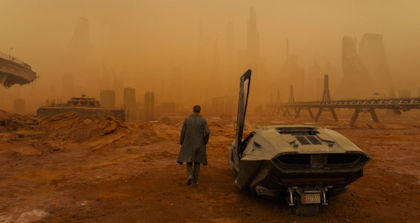2017 / cinema
SF elements: replicants
![[poster] [poster]](poster.jpg)
The IMDB plot summary for the original 1982 Blade Runner starts: “In the futuristic year of 2019, Los Angeles has become a dark and depressing metropolis, filled with urban decay.” It is now thirty years later: the the entire planet has undergone ecological collapse, and is a wasteland populated with Wallace’s synthetic protein farms to feed the millions living in the cities. (Are there also carb, fibre, and vitamin farms?) The urban decay has also worsened, post the mysterious Blackout that wiped or corrupted most digital data, and is filled with those who cannot afford to migrate to a better life off-world. Despite the bankruptcy of the Tyrell corporation after the previous trouble with replicants, Wallace [Jared Leto] has started up a new line of more obedient replicants. Police agent KD6-3.7 [Ryan Gosling] is one of these new replicants, a Blade Runner hunting down the earlier, dangerous models. His latest mission finds an old replicant living on a protein farm, but what he discovers there leads to an explosive revelation that could destroy humanity. He needs to find Deckard [Harrison Ford] to solve the mystery.

The new film is long (2hr 44mins) and has a rather dream-like quality. There are a few action scenes, but this is mostly K uncovering dark secrets, moving slowly through huge bleak strangely-lit exteriors, or densely-detailed strangely-lit interiors. This is surprisingly effective at generating a mood of quiet desperation. Gosling plays the part of a seemingly unemotional and obedient replicant very well: without cracking a facial expression, he nevertheless manages to convey the loneliness and misery of being a despised un-person. And Wallace, as both original saviour and now potential destroyer of humanity, is an interesting villain.
 Does it pass the Bechdel test?
Well, K’s boss police Lieutenant Joshi [Robin Wright] and
Wallace’s spooky replicant enforcer Luv [Sylvia Hoeks]
do talk about recent events at the forensics lab,
but that’s the only brief scene I can recall;
the short conversation between prostitute Mariette [Mackenzie Davis]
and sex hologram Joi [Ana de Armas] is about K.
And, of course, a major female character is
“refrigerated”
before the film even starts.
Does it pass the Bechdel test?
Well, K’s boss police Lieutenant Joshi [Robin Wright] and
Wallace’s spooky replicant enforcer Luv [Sylvia Hoeks]
do talk about recent events at the forensics lab,
but that’s the only brief scene I can recall;
the short conversation between prostitute Mariette [Mackenzie Davis]
and sex hologram Joi [Ana de Armas] is about K.
And, of course, a major female character is
“refrigerated”
before the film even starts.
While watching, the film is very engaging, pulling you along with the plot, despite its slow unfolding. It also manages a great plot twist that subverts a lot of the initial setup. It is only afterwards that some of the more ridiculous elements become clear. Why is Wallace blind? He owns replicant technology; surely he can make himself some eyes? The Blackout doesn’t seem to have been a very drastic event integrated into the past history, but only there to make tracking down details of earlier replicants more difficult. The deeper systemic effect of a digital purge is handled more effectively in Dark Angel. Given replicants are so dangerous and difficult to spot, why have their only identifying mark a serial number in one eye? Why not just give them, say, a bright blue skin, and tattoo their serial number across their foreheads? The one scene that did jar at the time was the comment that “no two humans have the same DNA”; I guess they’ve never hear of identical twins? Yet we were supposed to think twins, despite them being a boy and a girl.

However, for all these niggles (which occur in essentially any SF), the good more than outweighs the bad, and I enjoyed the film. With the evocation of a decaying future, and the underlying questions about what makes someone human, this makes a good sequel to the original masterpiece.
reviewed 3 November 2017